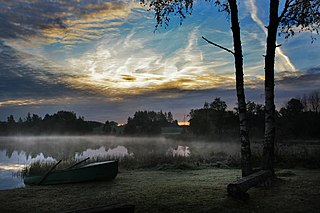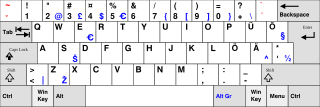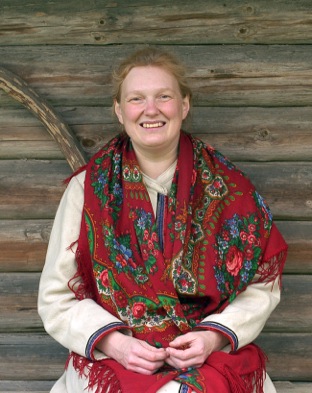
Estonian is a Finnic language of the Uralic family. Estonian is the official language of Estonia. It is written in the Latin script and is the first language of the majority of the country's population; it is also an official language of the European Union. Estonian is spoken natively by about 1.1 million people: 922,000 people in Estonia and 160,000 elsewhere.

Evar Saar is an Estonian linguist, journalist, toponymist a Võro language activist. He has traveled extensively around the historical county of Võrumaa and documented the original names of all major geographical features there. In total, he has collected over 50,000 names from the Võro language spoken in Southern Estonia.

Võru County is a county in southern Estonia. It is bordered by Valga and Põlva counties, Latvia's Alūksne and Ape municipalities, and Russia's Pskov Oblast.
Võrumaa was a historical county in Estonia. The historical Võrumaa includes the areas of the present counties of Võru, Põlva, Valga and Tartu.

Võro is the language of South Estonia, belonging to the Finnic branch of the Uralic language family. Governmentally, it has been considered a dialect of the Estonian language along with all varieties of South Estonian. However, many linguists consider South Estonian to be an independent Finnic language. It has its own literary standard and efforts have been undertaken to seek official recognition as an indigenous regional language of Estonia. Võro has roughly 75,000 speakers (Võros), mostly in southeastern Estonia, in the eight parishes of the historical Võru County: Karula, Harglõ, Urvastõ, Rõugõ, Kanepi, Põlva, Räpinä and Vahtsõliina. These parishes are currently centred in Võru and Põlva counties, with parts extending into Valga and Tartu counties. Speakers can also be found in the cities of Tallinn and Tartu and the rest of Estonia.

Setos are an indigenous Finnic peoples and linguistic minority that have historically lived in the borderlands between modern day Estonia and Russia. Setos have historically spoken the Seto language and been Orthodox Christians. The Seto language belongs to the Finnic group of the Uralic language family. Since the early 2000s, the Setos have sought greater recognition, rather than having their language considered a dialect of Estonian. Eastern Orthodox Christianity, with influences from local folk religions is widely practiced by the Seto peoples.

Võru is a town and a municipality in south-eastern Estonia. It is the capital of Võru County and the centre of Võru Parish.

Tartu Airport is an airport in Reola, Ülenurme Parish, 5.9 nautical miles south southwest of Tartu, the second largest city in Estonia. It is also called Ülenurme Airport due to its proximity to the village of Ülenurme. The Tallinn–Tartu–Võru–Luhamaa highway (E263) passes near the airport.

Seto is a dialect of South Estonian spoken by 25,080 people. It is sometimes identified as a variety under Võro, or the two are described as Võro-Seto. Setos mostly inhabit the area near Estonia's southeastern border with Russia in Setomaa, and are primarily Eastern Orthodox, while Võros are traditionally Lutherans and live in historical Võru County.

Võro Institute is an Estonian state research and development institution dedicated to the preservation and promotion of the Võro language and culture.

The official language of Estonia is Estonian, a Uralic language of the Finnic branch, which is related to Finnish. It is unrelated to the bordering Russian and Latvian languages, both of which are Indo-European.

South Estonian is either a Finnic language or an Estonian dialect, spoken in south-eastern Estonia, encompassing the Tartu, Mulgi, Võro and Seto varieties. There is no academic consensus on its status as a dialect or language. Diachronically speaking, North and South Estonian are separate branches of the Finnic languages.

Artur Adson was an Estonian poet, writer and theatre critic.

Estonian partisans, also called the Forest Brothers were partisans who engaged in guerrilla warfare against Soviet forces in Estonia from 1940 to 1941 and 1944 to 1978.

Sulev Iva, also known under the Võro-styled pen name of Jüvä Sullõv, is a Võro identity advocate, and a founding fellow at the Võro Institute. He has authored numerous subjects on Võro-related topics, and coauthored an ABC book and a reader of the Võro language for elementary school children.

Kauksi Ülle is an Estonian writer.

Kraasna is an extinct dialect of South Estonian that was spoken in Russia by the Kraasna Estonians who were immigrants to the area. The last native speaker likely died before World War II, but it was still spoken in the 1930s. Kraasna was documented by Oskar Kallas.

Kalle Eller was an Estonian publisher, neopagan, cultural researcher, educator and poet.
Hella Keem was an Estonian linguist and ethnographer.

Tiiu Kirsipuu is an Estonian sculptor.



















